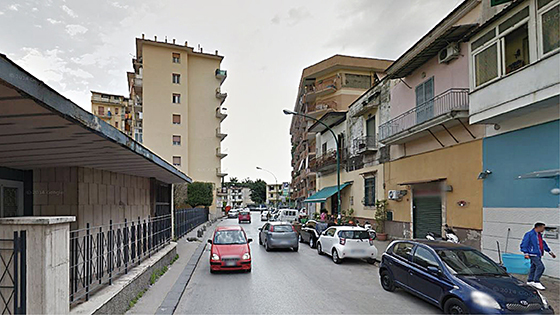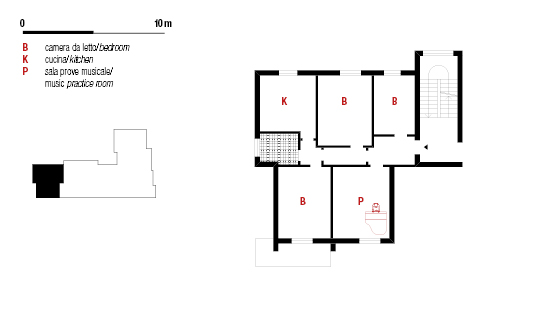2014/09/21
Casoria – nuovi emigranti/new emigrants
Cinquant’anni, già vecchio
Enrico Formato
Casoria, 1964. 102 mq, quattro stanze, una piccola cucina, il bagno in fondo al corridoio. Dalle finestre del settimo piano, il sole del mattino entra tagliente riverberando appena il nerofumo dell’acciaieria. Le automobili sono nei box, al lavoro si va a piedi o in treno: la ferrovia, i negozi, la scuola, le fabbriche sono tutte raggiungibili camminando, al massimo venti minuti tra i vicoli del centro. Ogni giorno, almeno un nuovo cantiere che prelude ad un condominio, abitanti neoproprietari, attratti dal lavoro e dalla vicinanza con il capoluogo, comprano a buon mercato appartamenti che ricordano i coevi quartieri collinari di Napoli. Anche se, a Casoria, il panorama non c’è. Nel condominio altri 41 appartamenti, tre a piano serviti da due corpi-scala con ascensore: 2, 3, 4 vani più accessori. Per tutti: luce, sole, logge, posti auto nel garage interrato. Al piano terra: farmacia, generi alimentari, l’ingresso comune, laterale e sacrificato per sfruttare ogni spazio commerciale. Comprare quest’appartamento borghese a Casoria, nel 1964, è più conveniente che prenderne uno analogo nel vicino quartiere Ina-Casa, il cui affitto a riscatto pesa troppo sul monoreddito familiare.
Cinquant’anni dopo. 102 mq, quattro stanze, una piccola cucina, il bagno in fondo al corridoio. Al settimo piano, tutto è com’era. La casa, ora abitata dalla seconda generazione, è uguale, nella distribuzione, a cinquant’anni fa. Una parete tinta di rosso, i pavimenti sostituiti per rifare gli impianti idrici e il riscaldamento. Il vecchio tinello – tavolo, buffet, arazzo alla parete – ha lasciato spazio ad uno studio con strumenti musicali, iMac, scrivania, un divanetto sotto la finestra. L’interno 41 è uno dei pochi ancora occupati da chi ha acquistato nel 1964 o dai suoi diretti eredi. L’appartamento a fianco, come altri in questo condominio, è da anni sfitto, in attesa di locatari affidabili o che il mercato immobiliare s’interessi nuovamente di queste case. Dalle logge solo altri condomini, palazzine, villette, ciò che resta dei palazzi del centro storico. Grandi vuoti, fabbriche dismesse, ora invase da una rigogliosa vegetazione spontanea. All’orizzonte spicca il totem dell’Ikea, illuminato notte e giorno, uno dei pochi centri commerciali ancora attivi. A terra tante, troppe, auto parcheggiate in strada. Tanti giovani a spasso, al bar, che contendono ai pensionati le poche panchine della piazza.
Casoria è un comune della prima periferia di Napoli. L’urbanizzazione, densa e caotica, si è sviluppata parallelamente all’incremento demografico, con la popolazione residente che passa dai 26.277 abitanti del 1961 agli 81.888 del 2001, con picchi d’incremento su base decennale del 110% (1961-71). L’urbanizzazione si è appoggiata su diversi fattori: 1) la facilità di accesso alla città di Napoli; 2) lo sviluppo produttivo, dapprima dovuto all’impianto di industrie chimiche e siderurgiche, poi, dagli anni 80, all’insediamento di centri commerciali e ludici. L’urbanizzazione degli anni del boom edilizio ha utilizzato il nucleo storico come matrice di un insediamento compatto, una “corona di cemento”, fatta di blocchi multipiano, 6/10 piani, aggregati a cortina, con negozi ai piani terra. Questo insediamento è dotato di una maglia infrastrutturale insufficiente, dipendente dai tracciati storici.
Alla dismissione industriale degli anni ottanta è seguito, nell’ultimo decennio, l’abbandono dei centri commerciali e dei servizi, con pesanti conseguenze sull’economia locale. La costruzione di nuove superstrade nell’area metropolitana di Napoli ha inoltre reso meno attrattiva la prima periferia, spostando l’interesse immobiliare nei comuni più esterni, dove il prezzo degli alloggi è più basso e migliore è la qualità ambientale.
Nell’ultimo decennio Casoria ha perso circa 4000 abitanti ed almeno altrettanti andranno via, secondo le stime, nei prossimi dieci anni. La “nuova emigrazione” è in buona parte alimentata dalle generazioni più giovani e dai ceti con maggiore grado di istruzione, alla ricerca di opportunità lavorative ed una migliore condizione di vita.
Fifty years old, already worn-out
Enrico Formato
Casoria, 1964. 102 sqm, 4 rooms, little kitchen, bathroom at the end of the corridor. The morning sun enters from the windows of the seventh floor. The dazzling light is barely blurred by carbon black produced by steelworks. The cars are in the garage; everyone goes to workplaces by walk: railway station, stores, schools and plants are all reachable by twenty minutes walking in the historic settlement. Everyday a new building site preludes to a new apartment house. New smallholders, attracted by workplaces and proximity to the city, acquire cheap apartments suggesting the modern hill districts of Naples. Even if, in Casoria, there is no panorama sight. In the building there are 41 more flats, 3 per floor, distributed by 2 stairways with lift: 2, 3, 4 rooms with restrooms. For everyone: light, sun, balconies, parking space in the basement. At ground floor: pharmacy, markets, the little hall door sacrificed in order to use every available commercial space. In 1964 it is more affordable to buy this middle-class apartment than to get a similar one in the nearby public housing scheme built for the Ina Casa program, where leaseholds weigh excessively on the middle-to-low family incomes.
Fifty years later. 102 sqm, 4 rooms, little kitchen, bathroom at the end of the corridor. At the seventh floor everything is as it used to be. The apartment, now used by the second generation, has the same plan than fifty years ago. A wall has been red dyed, the tiles have been changed in order to repair water system and install a new heating equipment. The old living room - dining table, sideboard, wall tapestry – has been replaced by an office with musical instruments, iMac, desk, a little sofa next to the window. The apartment number 41 is one of the few ones still occupied by the first homeowners or their direct descent. Many apartments in this building are vacant, waiting for trustworthy tenants or for an acceptable sale price. Looking out from the window one can see only other buildings, apartment and small-houses, what remains of the palaces of the historic center. Big empty spaces, abandoned factories and storage areas, now colonized by a lush and spontaneous vegetation. In the skyline the Ikea totem-sign, well-lighted night and day, indicates one of the few commercial centers still in activity. Too many cars are parked in the streets. Too many young persons strolling, chatting in the coffee shops, disputing with retired persons the few benches of the square.
Casoria is a town of the first outskirts of Naples. The agglomeration had a massive demographic growth between the 1950s and the 1990s, in parallel with the establishment of chemical and metallurgical industries: the resident population grew from 26,277 (1961) to 81,888 (2001). From the 1980s until the early 2000s industries were dismantled (the manufacturing sector is now almost absent) and large entertainment and business boxes were built: cinema and bowling complexes, shopping malls, business districts, etc. Finally, with the last financial and economic crisis, the entertainment-shopping-business “boxes” have experienced a gradual decline. The recent construction of new highways has diminished the advantages of Casoria’s proximity to Napoli’s city core, which is now more easily accessible from external locations where the environmental quality is better (due to the presence of larger green areas) and the housing market is more competitive.
Consequently, the resident population in Casoria has started to decrease: a gradual abandonment of the residences of this intensive, ugly and low-efficient city is currently occurring (the population was 77,000 in 2011), in parallel with a “new emigration”. It is expected that the resident population will total 73.000 inhabitants by 2023. The new emigration is largely composed by young persons, better educated, searching for employment opportunities and quality of life.
Guarda l’intervista in HD su Youtube/Watch the interview in HD on Youtube
№ 3/21
№ 1/1
Next project: → Genova – immigrati e proprietari/immigrants and house-owners
Previous project: ← Roma – ex patrimonio pubblico in vendita/historic public housing for sale

